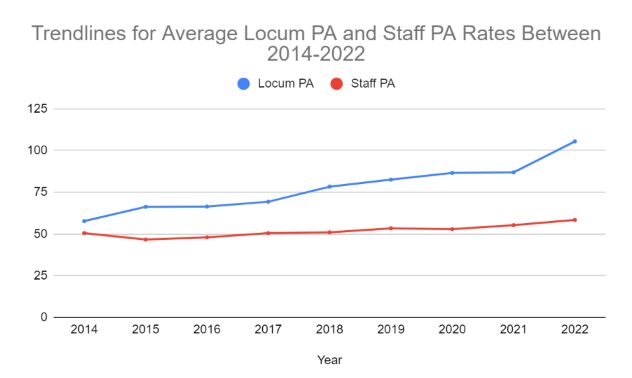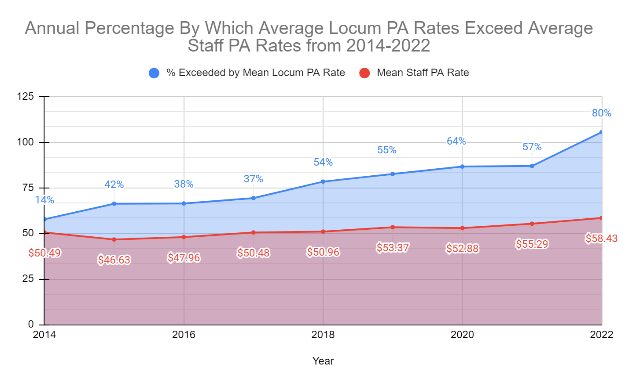
US News ranked physician assistants as the #2 Best Healthcare Job in their 2024 rankings, and as #5 in their 100 Best Jobs. This ranking was partially informed by Bureau of Labor Statistics projections that the PA profession will experience a 27% increase in employment from 2022 to 2032, which the BLS categorizes as “much faster than average” growth.
Current Physician Assistant Salary and Job Outlook
The average PA salary was $130,020 in May 2023, according to the Bureau of Labor Statistics. Locum tenens PAs tend to earn more, thanks to their ability to negotiate rates through their recruiter. A physician assistant specializing in anesthesiology, for example, could earn up to 67% more with a locum tenens job.
There are many job openings for PAs- about 12,200 projected each year on average, over the decade. In 2022, approximately 148,000 people are working as PAs. The physician assistant starting salary averaged $103,475 a year according to salary.com.
If you’re wondering how much more you could be earning with a locum tenens job, check out our calculator to see pay differences for permanent and locum tenens positions in your specialty. Whether you’re working as a locum, or are still considering making the switch, looking at past trends gives us a reliable glimpse into the physician assistant salary outlook of 2025, and years to follow.
Permanently Employed Physician Assistant Salary Trends
Overall, the average salary of permanently employed physician assistants has shown to be trending upward at a rate of approximately 2% a year.
This incremental upward trend, however, has not been 100% consistent throughout the past 8 years. While the average salary of a staff PA today is about 16% higher than it was in 2014, this growth did not come without a few steps backward along the way. Full-time PA salaries actually decreased between the years of 2014 and 2015 by -8%, and experienced another dip by -1% between 2017 and 2018.
Altogether, the good news about staff physician assistant work salaries is that the overall trend shows that PA base salary growth will likely continue to increase in the coming years. On the other hand, full-time PAs shouldn’t get too comfortable expecting a salary increase every single year, as history indicates the potential for unexpected pay declines in the future.

Figure 1: The represented data is a combination of internal data and externally sourced data from The Bureau of Labor Statistics and the AAPA.
Locum Tenens Physician Assistant Salary Trends
The average locum tenens Physician Associate hourly wage has also been trending up, but unlike the slow and steady growth rate of staff PA salaries, average locum pay has been increasing at a more rapid pace. Whereas full-time physician assistant salaries have grown by an average of 2% each year, average locum salaries quadruple that progress, with a mean annual pay increase of 8%.
Though locum PA rates have shown more accelerated progress overall, they too have seen periods of stagnation. In the year 2021, the locum PA income growth rate experienced a lull, having narrowly increased by less than 1% from the previous year.
This standstill, however, was only a temporary interruption to the continued growth of average locum PA earnings, which skyrocketed back up by 21% in 2022. It is also relevant to note that, though the average physician assistant pay rates for locums have undergone periods of slowed growth, at no time during the past 8 years have they decreased from one year to another.
Comparing Locum vs. Full-Time PA Salary Trends
Historic trends for both locum tenens and full-time average PA annual earnings are similar in more ways than one. Generally speaking, they both seem to be looking up for the future, but they’ve also both had their ups and downs as they have progressed.
When we take a closer look at these fluctuations, some key differences between average locum and permanently employed rates are revealed; particularly in the downturned years.
Staff PA salaries have undergone clear declines whereby average pay has actually decreased from one year to another, but the average growth rate of locum tenens pay has never gone into the negative. This finding indicates that while the growth rate of average locum tenens earnings may (rarely) be subject to standstills, it is highly unlikely to ever regress backwards once it has already increased.
Though locum tenens work gets a bad rap for being unreliable for providing stable income, the data shows the opposite to be true. Even when the mean locum PA wage growth rate hit a nearly complete halt between 2015 and 2016, the average locum tenens PA still earned an average of over 38% more than their permanently employed earns, even in 2022.

Figure 2: The represented data is a combination of internal data and externally sourced data from The Bureau of Labor Statistics and the AAPA.
Historically, the largest upswing in average annual pay for staff PAs is a recent bump up by 6% from 2021 to 2022. With a striking increase of 21% over the same exact time period, the 2022 bump in average locum earnings acutely surpassed that of full-time providers.
This contrast, however, is unsurprising since mean locum pay has remained, on average, 55% higher than mean full-time PA salaries over the inspected time period. Because average locum physician assistant wages grow at a typical rate of 8% every year, they increase more on an annual basis than average full-time PA salaries increased from their largest boom in 8 years.
Locum tenens work allow PAs to focus on prescribing medications, diagnosing and treating, and providing quality patient care without the politics, and at a better pay rate!
Get Hired
Ready to increase your earning potential with locum tenens? See how much more you could make using our salary tool and check out our open PA jobs!
This article was originally written by Karina Kagramanov and was updated by Liliana French.
